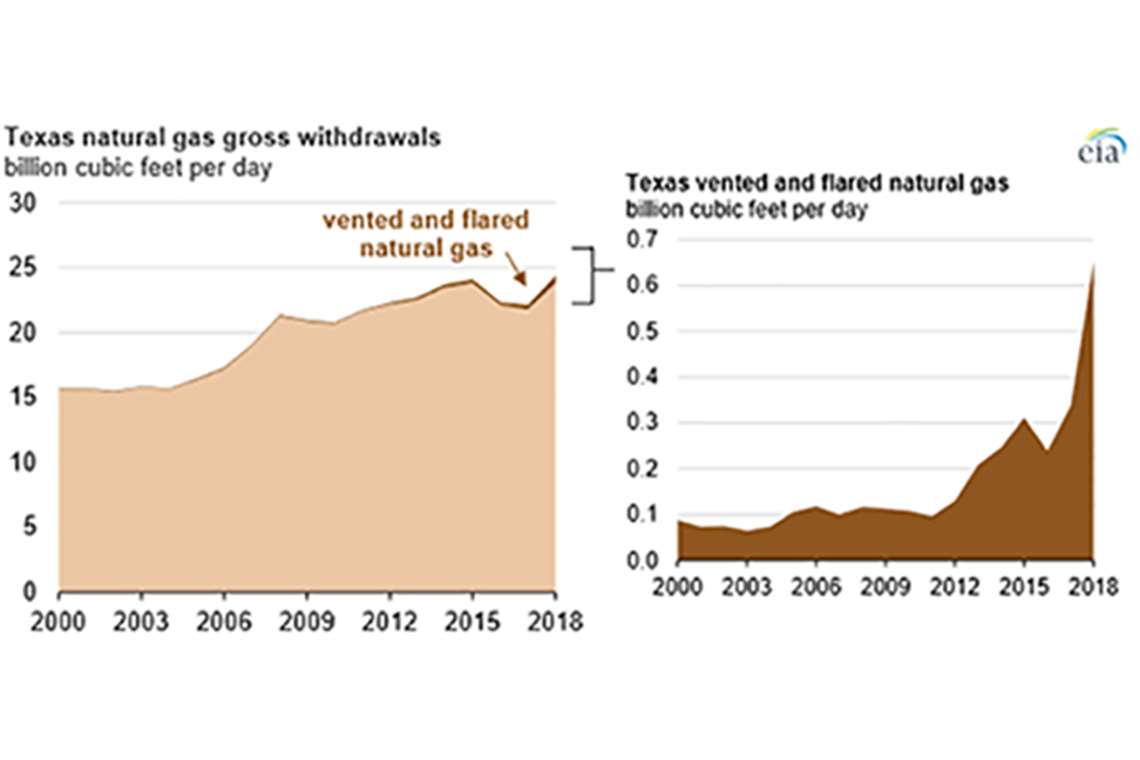Venting, Flaring Up In Texas, N.D.
06 December 2019

The volume of natural gas that was reported as vented and flared reached its highest average annual level of 1.28 bcfd in 2018, according to the U.S. Energy Information Administration’s (EIA) Natural Gas Annual.
In 2018, the percentage of U.S. natural gas that was vented and flared increased to 1.25% of gross withdrawals, up from 0.84% the previous year. Two states, North Dakota and Texas, accounted for 1.1 bcfd, or 82% of the reported U.S. vented and flared natural gas.
While neither venting nor flaring are looked on positively, of the two, flaring is preferred because methane, the main component of natural gas, is a more potent greenhouse gas than the CO2 that is the main product of flaring.
As crude oil production has outpaced the buildout of infrastructure to handle natural gas, associated gas — natural gas that is extracted during oil production — has been increasingly vented and flared.
In 2018, Texas and North Dakota accounted for 51% and 31%, respectively, of the total U.S. vented and flared natural gas. Both states are working with producers to limit the need for flaring without shutting down or affecting production of crude oil from new wells. Venting is banned in North Dakota and restricted in Texas.
As crude oil production from the Bakken play in North Dakota has grown five-fold between 2010 and 2018, natural gas processing plant capacity has not kept pace with the amount of associated gas being produced. In 2018, North Dakota flared 0.40 bcfd, which is 17% of total natural gas gross withdrawals in North Dakota and the highest percentage share of any state.
 In 2014, the North Dakota Industrial Commission (NDIC) established Order No. 24665 to reduce the amount of flared natural gas, but the current targets have not been consistently met. Expected completions of natural gas processing plant projects would increase the amount of natural gas that operators could capture, as would additional capacity on interstate pipelines to move the processed natural gas to market and reduce the amount of natural gas that is flared.
In 2014, the North Dakota Industrial Commission (NDIC) established Order No. 24665 to reduce the amount of flared natural gas, but the current targets have not been consistently met. Expected completions of natural gas processing plant projects would increase the amount of natural gas that operators could capture, as would additional capacity on interstate pipelines to move the processed natural gas to market and reduce the amount of natural gas that is flared.
In Texas, the Permian Basin and Eagle Ford plays have contributed to a rapid increase in the natural gas flaring in recent years. In 2018, vented and flared natural gas in Texas reached over 0.65 bcfd, nearly double the 2017 level and about 2.5% of total 2018 natural gas gross withdrawals in the state.
The majority of flaring permits received by the Texas Railroad Commission (RRC) arefor flaring casing-head gas from oil wells. Wells are permitted to flare for up to 10 days after completion to test for a well’s resource potential, but extensions may be granted while operators await connecting wells to natural gas gathering lines. The number of venting and flaring permits approved by RRC increased from slightly more than 300 in fiscal year 2010 to nearly 5500 in 2018. A number of new natural gas pipelines are planned or under construction to transport greater volumes of natural gas to market, particularly from the Permian Basin.
STAY CONNECTED




Receive the information you need when you need it through our world-leading magazines, newsletters and daily briefings.
POWER SOURCING GUIDE
The trusted reference and buyer’s guide for 83 years
The original “desktop search engine,” guiding nearly 10,000 users in more than 90 countries it is the primary reference for specifications and details on all the components that go into engine systems.
Visit Now
CONNECT WITH THE TEAM









